George Watson’s College – Staff Transgender Training
A member of the public recently attended the school’s transgender training webinar for teachers. As expected, much of the content is of concern, in that it unquestionably affirms gender identity ideology and breaches the Equality Act provision for single-sex facilities. The host from LGBT Youth Scotland also revealed that the long overdue replacement transgender guidance for schools will be published shortly and that, contrary to the Cabinet Secretary’s statement, it has not been written by the Scottish Government, but is an extension of LGBT Youth’s current guidance – which was previously deemed “not legal” by Ministers.
We were also rather surprised to see several pupils on the webinar video, given that it was a staff training session. This was particularly worrying given the lax security around signing up for the webinar.
The transcript is as follows:
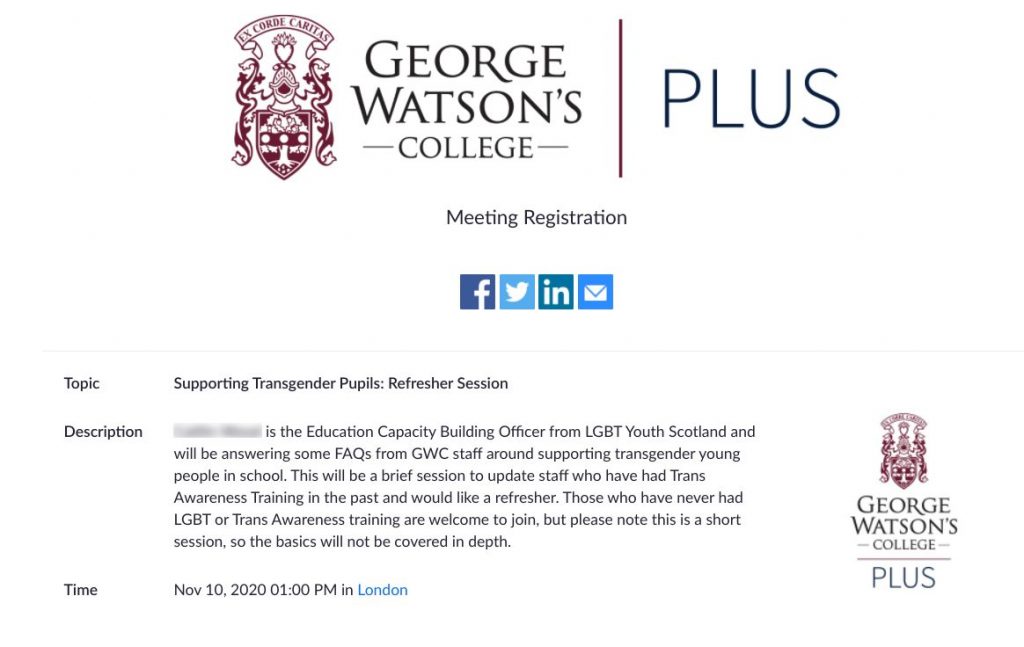
Speaker 1 – Education Capacity Building Officer, LGBT Youth Scotland
…questions. Alternatively, given that we’re quite short on time, you’re more than welcome to just keep track of questions and email me after. And I can kind of get to the questions after the session today, because I’m aware that there might be some stuff that I’m going to really lightly touch on that some people might have no information on. And other people are going to have quite a lot of information on that. So I also want to apologise it’s quite a text heavy presentation, which is something that I try hard not to do. But given we have a short session, I just wanted to make sure all the information was there today displayed so that you can kind of have a read of it. And I’ll be sure to send the presentation through at the end as well. So don’t feel like you have to write down every note that’s on each slide. But feel free to keep track of any questions. As I said, I can answer them after.
And so what we’re going to look at today is a really quick light revision of two definitions. We’re going to look at, kind of, social transitioning. So when we’re talking about trans pupils, transitioning in a school environment, as many of you might know, we’re typically talking about a social transition. So we’re not going to really focus on a medical transition today, because that’s something quite different. And another conversation in itself, we’re going to look at some key policy and legislation, because I had some questions sent in from the audience a couple of weeks ago. Just some, like key questions that people have had, that they’ve been curious about. So I’ve tried to answer them throughout. And then we’ll do some like q&a at the end as well.
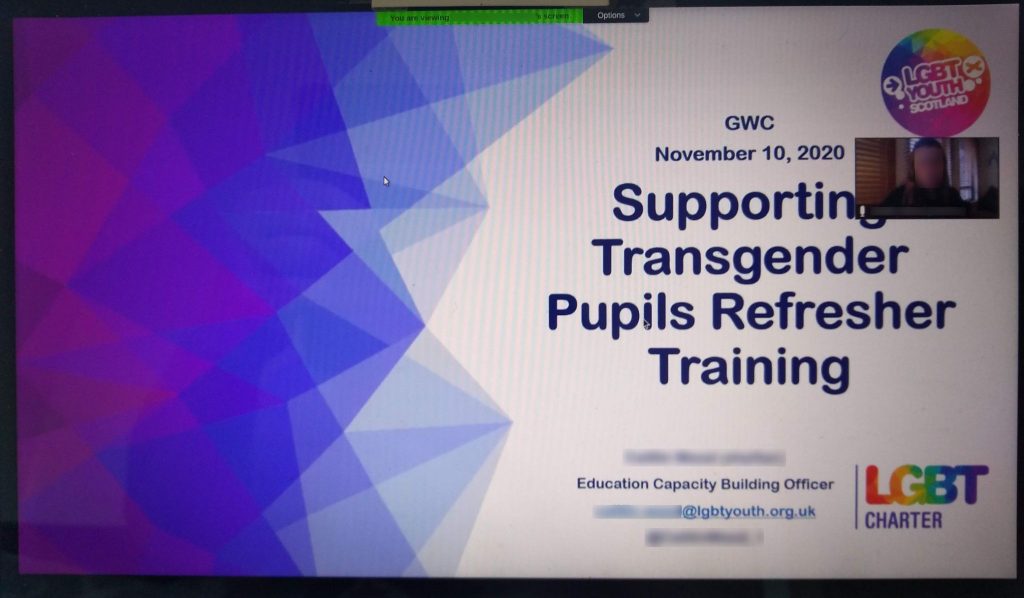
So I should introduce myself, because I have not started at that point today. So I’m going to rewind a bit. So my name is [Host’s name], my pronouns are she/her, and I’m the Education Capacity Building Officer with LGBT Youth. Some of you might remember [LGBTYS employee’s name], who took the school through the charter programme in the last couple of years. I’m essentially the new [LGBTYS employee’s first name] and have been for the last year and a half. So a lot of my role is predominantly based on supporting schools, on becoming a more inclusive LGBT environment, and looking at kind of tangible things that practitioners can do in their practice, but also things that we can do in the curriculum in our school. And in kind of maybe those small changes that we don’t think will have a big impact. But based off our experience working in schools, we do, so we’re going to kind of like cover all that today.
I wanted to start off by also saying that I know a lot of people kind of attend LGBT training, and they have certain expectations, or they have these fears that the reason they’re here is because they have fears on not really knowing how to best support LGBT pupils. They don’t want to say the wrong thing. They don’t want to offend anybody. And that all comes from the greatest, you know, the best place of intentions. But today, I kind of want to make sure everybody finishes this session with a bit of pressure taken off I guess, that weight’s taken off. You’re not expected to have all the answers, you know, this is my full time job. And I certainly get things wrong. Young people pull me up on (hello to anybody that’s just joined us, welcome) certainly get things wrong myself. So today is definitely not about 30 minutes, we’re going to give you a quiz at the end do you have to get 100% right on that test. It’s really about kind of remembering what all this is about in the first place. And it’s ensuring that we get it right for every child and that every pupil, regardless of gender, or sexual orientation, you know, feels seen and included and valued in school. And that’s really, you know, what we used to do as teachers, you are getting it right, you know it GWC.
Speaking before, to [Teacher 1 name] and [Teacher 2 name], more particularly [Teacher 1 name] talking about the LGBT group. You know, there are growing numbers of pupils that attend that group, and a growing number of young people that are identifying as gender non-conforming, trans or non-binary, compared to the last, let’s just say three years. So there’s definitely something that’s happening, you know, in the ethos and the culture of the school, so you can be kind of, hopefully rest assured knowing that there is that happening already. And there are teachers that you can talk to as well.
Um, so let me just see here if this is gonna work. Right, so to dive in, the term transgender, I was going to ask you Oh, well, actually, no, I am going to ask if anyone, I can see you, like munching on lunch and whatnot. That’s fine. I am rather jealous. But if anyone wants to be the brave soul, I know I hate being in meetings like this when someone’s like, ‘Okay, now we’re going to engage the audience and everyone talk’, if anyone does feel like a brave soul and wants to try and define the term transgender. I would love for someone to attempt that now, I’ll give us about seven seconds of awkward silence. And if no one does jump in, I’ll just I’ll dive in with the definition. But can anyone have a go at defining what transgender is, even in your own words doesn’t have to be an accurate definition. Googling is allowed because I can’t see.
Speaker 2
I’ll have a go.
Speaker 1 – Education Capacity Building Officer, LGBT Youth Scotland
Okay.
Speaker 2
And so is it that someone who when they don’t identify as they are given, I might say the wrong term here, is it sex.
Speaker 1 – Education Capacity Building Officer, LGBT Youth Scotland
Yep. Yeah, essentially. So the best way that we describe it is it’s an umbrella term. So an umbrella term for people whose gender identity and gender expression differs in some way from the sex assigned to them at birth. So essentially, exactly what you said. So the way that we typically might see this in, you know, the real world is trans boys and trans girls, like so in terms of pupils, we have the trans umbrella. So under that umbrella sits trans men or trans boys and trans women and trans girls, as well as non-binary. So when we talk about gender identity, we’re talking about our internal perception of our gender.


So for me, I was assigned female at birth. And as a [age] year old, I identify still as a female. So the term for that is gender. So we have the term cisgender. And we have the term transgender, so transgender for people that are not like me, so they don’t associate or identify with the sex that was assigned to them at birth. And when we talk about cisgender, and transgender, they can be really helpful terms to know. I remember when I was in school, not that we really spoke about trans identities in school, but I would sometimes hear trans people and normal people. So the term cisgender, or cis is a really helpful word in terms of, you know, the use of equality in our use of language, so that we don’t kind of differentiate in that way. And I would say mostly people are well aware of that these days, but potentially has some family members that might need a little help. I know, I certainly do, in terms of give little help around the language. So we have trans people, and we have cis people.
So as I said, kind of when we talk about identity, that’s our internal perception of our gender. When we talk about expression, obviously, there we’re talking about our physical features, how we dress, potentially our voice. You know, how we accessorise, how we wear our hair, makeup, whatever it might be, basically, how we express our gender. And you might see some pupils in school that are not necessarily trans or don’t openly identify as trans, but might express their gender in a different way than you might assume, based on the sex that they were assigned at birth. So we call I guess, essentially, in terms of gender non-conforming people, they kind of might fit into that bracket. It’s just young people that don’t necessarily conform to our stereotypical idea of gender.
And in terms of the trans umbrella when we talk about non-binary people, and I’m aware again, I’m gonna like, talk, talk, talk talk at you, unless someone interjects, but I’m also aware it’s lunchtime, and you might just want to sit and listen. So that’s totally okay. Do feel free to interject at any point. When we talk about non-binary identities, these non-binary identities of people who do not identify exclusively as a boy or girl, so you can see for instance, my name on my screen there today, [Host’s name], just underneath my face. And you can see next to my name, I’ve put in brackets my pronouns, so my pronouns are she/her. Non-binary people, and some trans people might prefer to use the pronouns they/them. Does it, do you have any pupils or even staff in school that use they/them pronouns? Do you know? Yes, some people nodding, yeah, cool. Um, and this might be these pronouns they/them might have been what you were introduced to, you know, with that young person they might have or when you first met them used he/him or she/her and they now use they/them. And that’s just the journey, you know, that some young people and adults, you know, go through in terms of understanding what feels comfortable for me.
You know, young people also might experiment with pronouns, you know, in our youth groups, it’s actually, we introduce ourselves with our pronouns, every group. I’m not a youth worker, but having been to many of those groups, we’ll introduce our name and our pronoun every time even though we know who we are. Because young people might experiment with pronouns, so one, one week, they might be using she/her, and next week, they might be using they/them. And that might sit for a little while. And it’s really helpful to support pupils in kind of understanding, you know, what does feel right for me, um, and that it’s really not a big deal to to use a different name, if you’re not comfortable with the name that you were given at birth. It’s also totally fine if you’re a trans person, and you don’t want to change your name. You know, it’s very, very, very much up to that individual. Do we have any questions on those definitions there?
So, when we talk about, I guess, transitioning, this is a question that I do get a lot, I think people are quite interested in what does, you know, a transition look like and again, is very, very different depending on every individual. It’s important to understand that some trans pupils might wish to transition so from male to female, or male to male, and that could be in a variety of different ways. I often will have teachers kind of email me worried about how they best support a pupil because they’ve said that they want to transition. And I think, because there’s so much information out there and the media have lots of ideas, it can be hard to understand like, okay, well, what is it as a teacher as a practitioner? Like, what am I actually, what is my position? How am I supposed to support this pupil? And often teachers I find, will jump to that end endpoint. Okay, well, we’re going to get you on the gender identity waiting list, you know, do we do you want us to change your pronouns in your name, but actually, that pupil might not want any of that. So understanding, you know, what it is that they need in that moment, is really important. And it might be really simple things. And when we talk about a social transition, you can see on the screen here, it might be that that young person wants to use different pronouns.
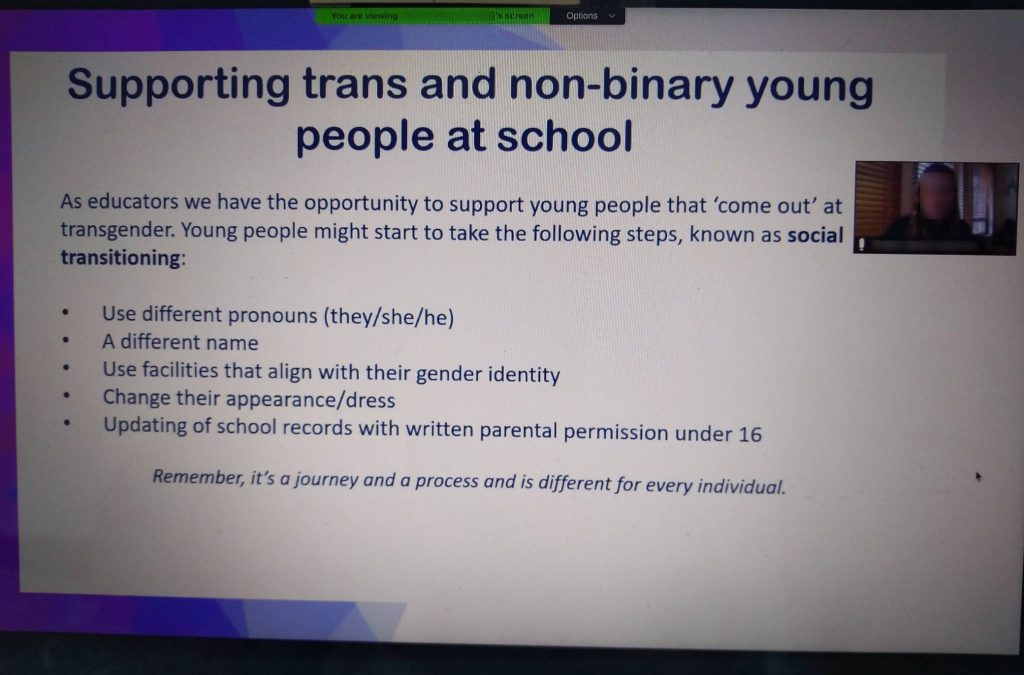
So it can be supporting young people with that, it’s not uncommon in my experience for a pupil to come out to a teacher, and ask if they use different pronouns for that teacher, then, typically guidance, I would say that, to then support that pupil by letting other staff know as well. You know, sometimes a pupil might need that support that it can, you can imagine, it’s really challenging to come out to one person, having to tell every teacher, you know, that you are using a different pronoun, can be really quite overwhelming. So sometimes staff might be able to support a pupil through that process. It could be a different name and these can both be changed on the official records on SEEMiS, it might be using facilities that align with their gender. So for some trans pupils they might wish to use different facilities than what you have known them using, others might want to stay using those facilities. And that’s a really nuanced conversation to have, with that individual pupil as well. At all times, we want to ensure that pupils feel safe in terms of using facilities, but really engaging that individual trans or non-binary pupil about what will make them feel more safe in the school as well. They might change their appearance, they might change the way that they dress. And then in terms of updating school records, not sure if you’ve done this, [Teacher name] at all, with pupils that under 16s there’s that parental permission as well, and I’ll kind of dance back around to the kind of parental support which somebody had asked around how to navigate that with the family home too.
In terms of key policy, a couple of people have kind of asked, you know, what policy or legislation is there in doing this work? And the answer is plenty. There’s a lot of key policy within schools, and then also Scottish legislation. So, you know, education policy and approaches, I guess, if they had to help us use, you know, professional judgement and establish context and content and manner in which they’re carried out. So they’re there, and they’re there to then figure out how do we use that in this particular situation.
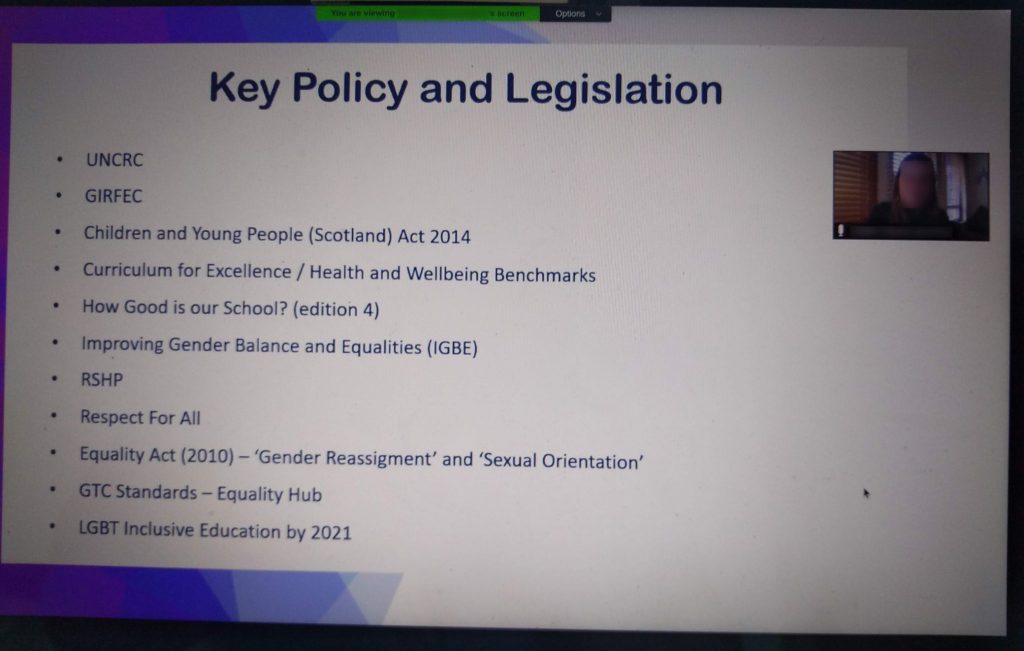
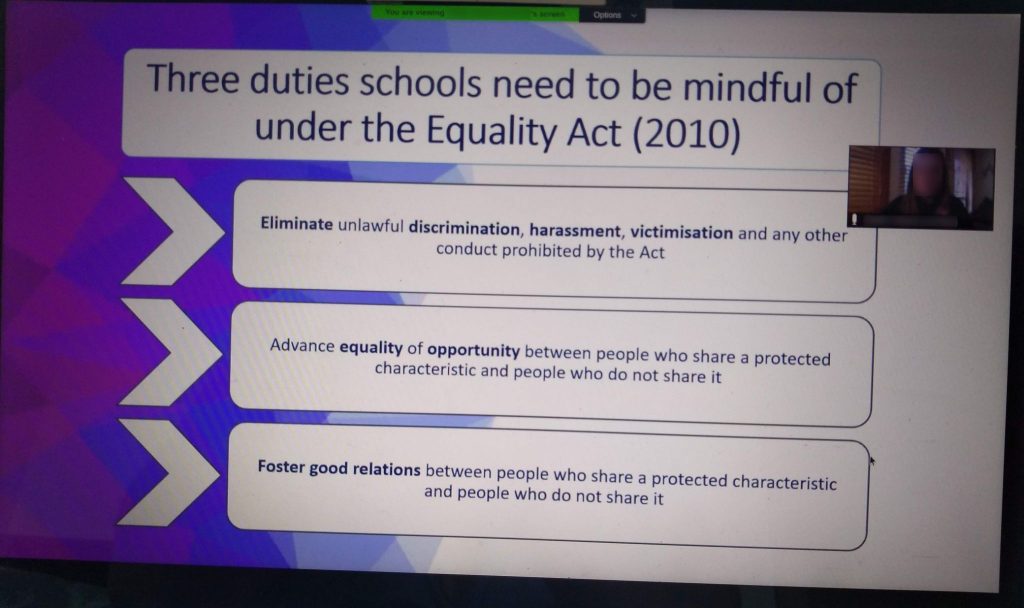
So we’ve got the United Nations Convention of the Rights of the Child. So there are particular articles in there that are quite pertinent to trans young people. I’m not going to go through all of these, but I’ll kind of just list them out. Just in case for accessibility. We’ve got GIRFEC, so getting it right for every child, the Children and Young People Scotland Act. And then there’s the curriculum for excellence with the health and wellbeing benchmarks, and within those benchmarks, even by the time young people have finished primary school, one of the health and wellbeing benchmarks for primary school aged pupils is that they should be able to understand the diversity of identities and sexual orientations. So by the time they get to secondary school, there should be that work already happening in primary schools. And how good is our schools? So with school inspections, more increasingly from 2021, inspectors will be asking about equalities work, specifically LGBT, and the improving gender balance and equalities, relationship, sexual health and parenthood. So if anyone hasn’t seen that resource yet, rshp.scot, I highly recommend, that is great for obviously, for PSE classes, but there are, there’s content in there on LGB identities and transgender identities, homophobia, biphobia, transphobia, sexual health for all, you know, kinds of young people, respect for all, and then obviously, the Equality Act in terms of legislatively speaking, you know, we have duty, we have duty as schools, as teachers to ensure that those that sit under the gender reassignment protected characteristic, which is essentially transgender individuals, and those that sit within the sexual orientation protected characteristic are cared for, you know, in our schools.
And then there’s the GTC standards and the inclusive education. I’m not sure if many people know about that. But essentially, Scottish Government are committing to inclusive education more than they ever have in you know, previously, and that will include a lot of changes in schools around ensuring that this work is happening. Does anyone have any questions? Sorry, I know I’m not, it’s, no, no. You’re all teachers, you know what it’s like talking all day long. But it’s so strange just talking to the computer screen and just having people like, um, this is the first time I’ve done a kind of external training before. So I’m aware that I am talking a lot. And also I know how annoying it is when someone says I’m aware of talking a lot. So I’m going to stop saying that.
And so we have the duties for schools, you know, when we talk about, you know, why is this work important? If we kind of sometimes need to be reminded of the foundations of this work, you know, where parents sometimes ask, you know, why are we focusing so much on LGBT identities, you know, we have a duty under the Equality Act to ensure that all protected characteristics have equality of opportunity, and that we foster good relationships between those characteristics. There are certain challenges that trans pupils face in school. And, you know, this is obviously not an exhaustive list. But if we think about how can we best support trans pupils? I think it’s important to think well, what obstacles are they facing? You know, without kind of understanding the things that we might need to focus on or fix or look at, it’s hard to know exactly, you know, where we want to get to. And statistically, we know that trans pupils are one of the highest groups of pupils to experience bullying, specifically transphobic bullying. One of our surveys, we release a survey every four years and over 90% of trans pupils had experienced bullying on the basis of being transgender or a perceived transgender identity. So this is something that, you know, is really important to look at.
In terms of the obstacles that pupils face, you know, particularly trans and non-binary. And remember when I’m saying non binary-individuals, rather when I say trans individuals, I’m often talking about non-binary young people as well because they sit under that umbrella. So I’m not talking about just pupils that are looking to like transition, I’m talking about non-binary individuals as well. So these pupils, you know, might face discomfort through puberty, there could be a feeling of being uncomfortable in class, biology and sexual health, PSE, facilities, bullying, mental health, joining in physical activities, PE, and also difficulty with other pupils and staff not being educated on the issues. So how can we overcome these challenges? There are many different things that you know, you’re probably already doing. But sometimes it can be a helpful reminder, I think, to understand you know, what is best practice, what is best practice and what’s happening throughout Scotland.
So in terms of, you know, curriculum inclusion, thinking about for your department, subject areas, you know, are trans voices represented, are trans experiences represented. We have and I’ll send out a list of kind of resources and signposting after the session today, but we have a resource called it’s basically an inclusive curriculum LGBT resource. And it’s focused on each subject department area, and it has tips and ways in which you can look at your department’s subject as well. But when we’re talking about being, trans voices being represented in our curriculum, quite often we hear from pupils that they might have a one off session. Or it might be mentioned once in a particular class, but really, in order to create, you know, social change, and to address prejudiced views and ideas about trans people, really needs to be thread throughout the curriculum.
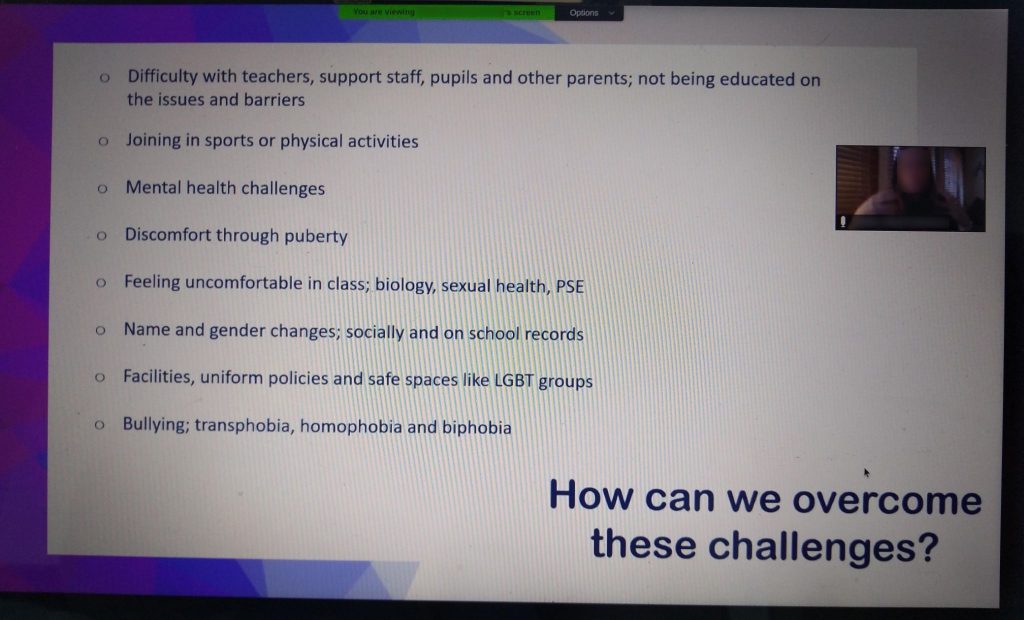
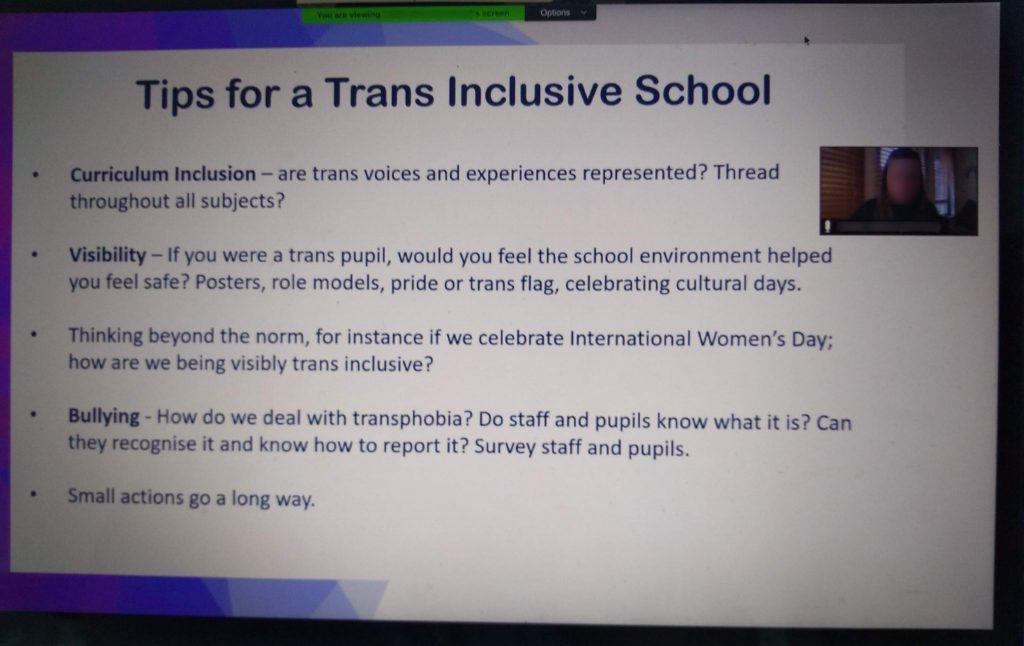
And when we’re talking about, you know, representation of voices, we’re talking about a multitude of trans identities too, I think it’s a great, it’s important to address that trans identities are not a one size fits all, and that we don’t want to perpetuate a stereotype about what a trans person is, what a non-binary person looks like. So thinking about the different trans people that we can, you know, visibly represent. If you think about, and I know there are pupils in the room with [Teacher name], and they’re welcome to jump in at any point if they have any thoughts on this. But if you were a trans pupil, you know, would you feel safe in the school environment that you currently operate in, if you walk around your school? Do you see yourself reflected in any of the posters in any of the campaigns or activities that are run each year? Are there role models? Is there a pride flag? Is there a trans flag? Do we celebrate cultural days, am I represented, you know, am I seen? And having a think about that, you know, just walking to your next classroom might be really helpful to just think not even just trans pupils, you know, all protected characteristics? How are they represented and reflected in our school environment? Thinking beyond the norm as well, you know, for instance, when we celebrate International Women’s Day, you know, are we being visibly trans inclusive? Do we have, you know, trans female role models and people that we want to celebrate? When we deal with bullying, you know, how are we dealing with transphobia?
And I think even coming back to basics, you know, do staff and pupils know what transphobia is? If you would ask a pupil, can you list for me some trends [word not entirely clear], or actually, this might not be the best thing to do cause it’s kind of perpetrating stereotypes, but you could ask stuff, you know, what are, what is transphobic? What would be deemed as transphobic? I think quite often, in my experience, working with staff, it can be really subtle, kind of micro aggressions that trans pupils deal with every day, to the other end of the spectrum, where it’s really overt and really explicit kind of transphobic comments, and remembering that, you know, small actions, they really do go a long way.
And you can remember from your time in school, at least for me, I, there was no LGBT representations, you know, in my school, and for young pupils that were LGBT in that school. Many of my friends didn’t come out as LGB or T, until well after high school, and I’m sure that has to do with the environment, right. And I’m sure your experiences aren’t that much different. So those small actions really can go a long way, even if it is wearing a rainbow lanyard yourself, or, you know, a badge or having a little pride flag or a trans flag sitting on your desk.
Just, okay, I’m going to move on now, because I’m just aware of time actually. Sorry. Okay. I’m going to jump to some questions here that kind of came through before the session. But does anyone have any questions or comments? We’ve got some notes from the pupils coming in, which is awesome. Thank you, [Teacher name].

Okay, cool. So [Teacher name] is just chucking in some notes from the pupils there. So we might come back to them if they do come through. But so one of the questions was around supporting pupils whose parents are not supportive of their gender identity, and supporting that family relationship. And this is, in my experience, I find this really tricky, and I definitely I don’t have necessarily, you know, a one size fits all approach to this. What we do know is that evidence shows that young people who have parents that are supportive of their trans identity, they’re more likely to have better mental health, improved self esteem and reduced rates of depression. So it’s important obviously, that you know, parents and carers they might have very legitimate questions you know, about, what it means if their child has come out as trans, or what happens next. And it can be that real fear, and it comes from a good place, right, in ensuring that their child, considering the statistics doesn’t fate, you know, isn’t just another one of those statistics. And I think that those negative reactions come from many different places, but it can come from having kind of inaccurate or incomplete information. So as a school, you know, you can ask those questions, ask them what their concerns are, and see if you can fill in those gaps and give them that correct information, your factual information. Um, you know, and it could be that they’re worried about what the future is, you know, for their child and what the school might do to support them. So you can allay their fears, by ensuring that they come on that journey as well.
It’s important that we create opportunities for you know, young people, obviously, to be heard, you know, and sometimes facilitating that with a family can be quite helpful. And in terms of kind of what I’ve got on the screen here, I think explaining your duties, you know, under the Equality Act, and policy as practitioners, I’ve had some schools kind of suggest to me that they’ve had parents that are quite strictly and explicitly not supportive, and they don’t really want to have anything to do with what’s going on. And it can be helpful for a teacher to say that, you know, we have a welfare responsibility as a school to provide a safe space for all young people, regardless of gender, sexual orientation, race, belief, any identity. And as practitioners under the Equality Act, you know, that is that that is our duty. So whilst it’s really important to take, you know, parents and carers concerns into account, it is also your duty to hold the pupil at the centre of what’s going on and ensure that they feel supported.
We have a Supporting Transgender Young People in Schools guidance, which has a child’s plan within that document, which might be worth having a look at if anyone is dealing with this. And it’s, basically just lays out a sequence of events that a school can undertake to support a trans pupil. I think I can say this, so I’m going to say it now. But that particular guide is soon to be Scottish Government guidance, which is really exciting. So it’s going to be non statutory guidance for schools on supporting trans pupils, and hoping that will be released by the end of the year. So that should also provide schools with some really clear and explicit information about what’s expected from the Scottish Government. And that’s based off the current guidance that we have on our website.
Speaker 3
What’s that called [Host’s name], sorry.
Speaker 1 – Education Capacity Building Officer, LGBT Youth Scotland
Yeah, go for it.
Speaker 3
Working trans.., what document was that called?
Speaker 1 – Education Capacity Building Officer, LGBT Youth Scotland
Yes, so Supporting Transgender Young People in School. And I’ll send, I’ll send the link as well, or an attachment of the of the document. But honestly, that’s, that is my life Bible, so to speak. You know, that is best practice. It’s what Scottish Government will hold practitioners to account so to speak. So yes, it’s really, really helpful to look at.
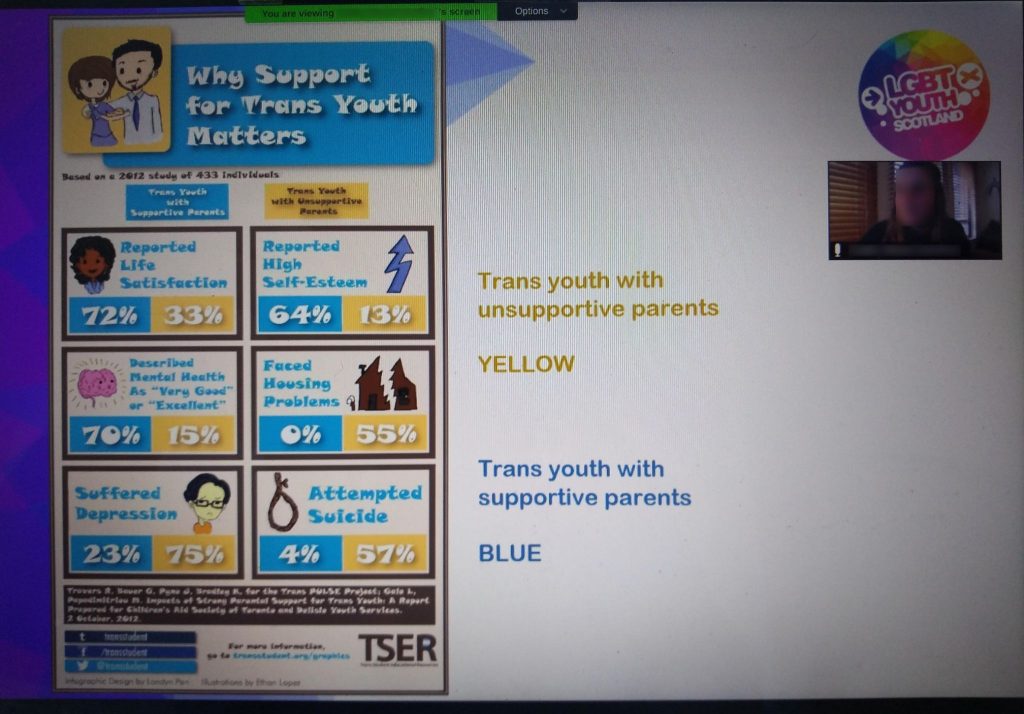
Um, this is just a really quick kind of, so sorry about the text on this. It’s just a screenshot. But, oh I just spat, sorry, um, so this is a I guess a diagram of the blue is trans youth that have supportive parents. And then the yellow is trans youth who have unsupportive parents. And you can just see like the incredible difference between statistically how young people feel about their life satisfaction, their self esteem, their mental health, their happiness, attempted suicide, suffered from depression.
Speaker 4
[Host’s name] sorry, can I just interrupt for a few seconds? Yes, sorry. That’s really, really helpful. Thanks for this. I’m just really conscious of the time and there’s been a couple of questions just posted in the chat box. Would it be possible just to maybe answer some of those if possible?
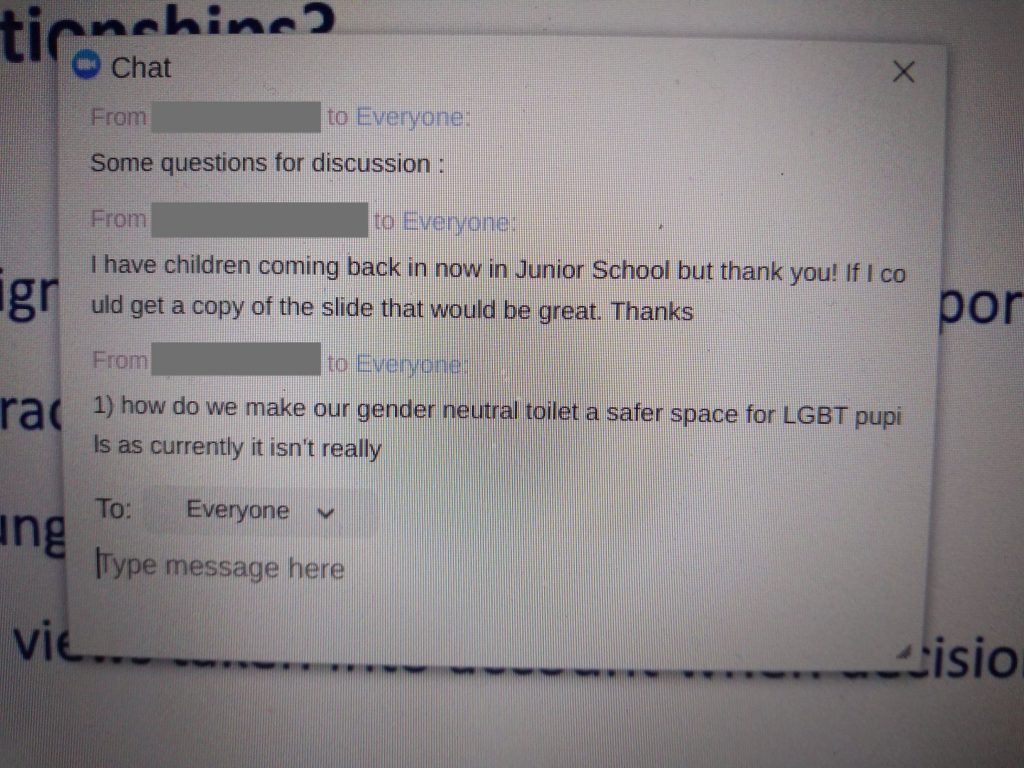
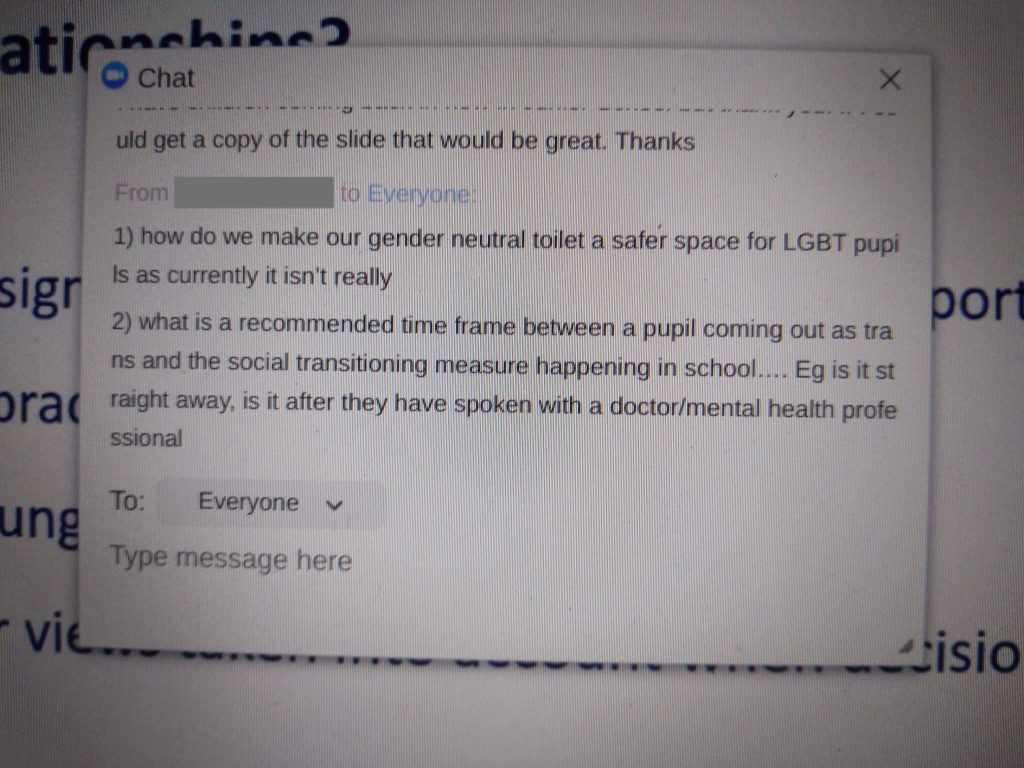
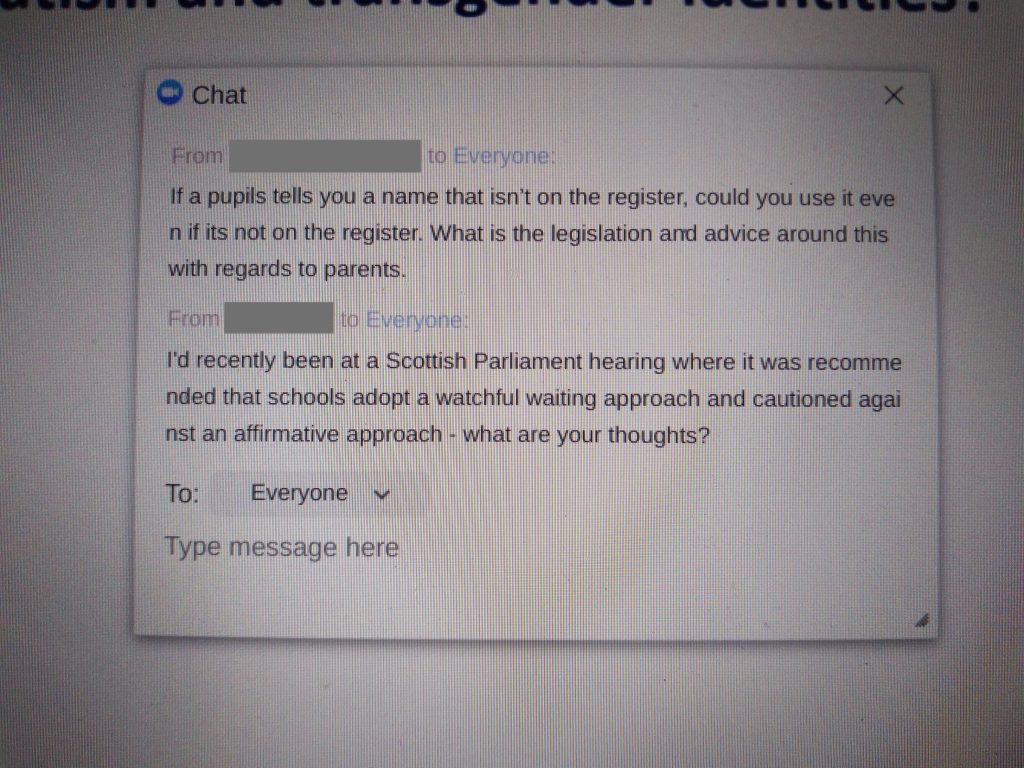
Speaker 1 – Education Capacity Building Officer, LGBT Youth Scotland
Yep, yep. No worries.
Speaker 4
Yeah. Just if that’s just time wise, we are kind of, we’re a little bit limited.
Speaker 1 – Education Capacity Building Officer, LGBT Youth Scotland
Pushing it. Yeah, no worries. But, um, in terms of, yes, you can get a copy of the slides. So gender neutral toilets and safe spaces for LGBT pupils. So do you currently have gender neutral spaces in the school for toilets, or facilities, does anyone know?
Speaker 4
So we do have a gender neutral toilet, which we’ve had for a couple of years now. Um it’s not, it’s not exactly gone perfectly, em, so there’s still some kind of work to do in that area in terms of it being a space where, em, trans pupils will feel entirely comfortable. It’s just is there any advice on how we can kind of police that or facilitate that a bit better.
Speaker 1 – Education Capacity Building Officer, LGBT Youth Scotland
Yeah, I think um, I think firstly, which you probably have already done but definitely engaging the pupils, all pupils, on the use of that, you know, facility as well, ensuring that one they know it’s there. And I guess the challenge is, I can understand that it kind of feels like you’re being singled out in a way, just having that kind of one space. And it can be quite daunting using that particular facility. So if there’s the possibility of having more facilities. Obviously, you don’t have the luxury of being a new school, but a lot of new schools are built gender neutral with gender neutral facilities now. But if there’s the possibility to have more spaces, and I think in terms of it takes time, I think, you know, it’s definitely something to engage the LGBT pupils about, and obviously, some of them are in the room with you now, but understanding like, what are the obstacles that they’re specifically facing? Why might they now want to, you know, use that facility? Do you have a sign on that facility at the moment?
Speaker 4
Yes, so there is, there’s a sign and like, everyone’s really aware of it, like across the school the pupils know where it is and different things, but it’s just that it’s been in some ways, like used by say, like, a group of S6 boys that, you know, could appear predominantly, maybe start to use that toilet and then socially that it pushes out, perhaps, you know. But yeah, I think what you said there was helpful about it, it’s definitely something we need to talk a bit more about.
Speaker 1 – Education Capacity Building Officer, LGBT Youth Scotland
Yeah. Yeah, definitely. And I think in terms of pupils that shouldn’t be accessing it that, ah, it can be challenging, too, because there could be a real reason why that particular individual is accessing that toilet. So, you know, I wouldn’t necessarily, try not to jump to the conclusion that they’re you know, kind of well, taking, you know, pulling your leg, so to speak. So even engaging with those individual pupils, like, do you know why we have this particular facility? You know, the reason we have it is because of a, b, and c, and it’s really important that the pupils that need to access it, you know, feel safe to do so. So I think engaging kind of all pupils around the use is really important.
Um, so what is the recommended timeframe between a pupil coming out and social transitioning? This is a good question. Um, I think so, in terms of, and I’m really trying to, like quick fire answer these, but um, in terms of a pupil coming out as trans, I think it’s important to remember or even ask, you know, how long have you been thinking about this? You know, how long has this been something that’s been floating around in your head? How long have you been feeling like this? Because whilst that pupil might have come out to you now and want things to happen really, really quickly, they may have been thinking about this for five or six years. So it’s important to acknowledge the work that’s kind of been done internally. But also, the reality is that, you know, things aren’t happen instantly. And particularly, Hello. Particularly in a…
Speaker 5
A live question. That’s why I’m going on about it. Yeah, I was just thinking because like, would I as the teacher be allowed to ask such question? Or would that have to come from a specific like, would Guidance be asking those questions? It just feels awkward and like your prying.
Speaker 1 – Education Capacity Building Officer, LGBT Youth Scotland
Yes, has that pupil come out to you specifically then?
Speaker 5
Yeah, so I received an email from a pupil on Sunday evening, saying sort of as of tomorrow, please refer to me by this name and this pronoun. And I was, I was a little bit taken aback, actually. I was obviously respectful as that, you know, fine no problem. But at the same time, I wondered, is that just to me, is that to, and I think it was to a selection of teachers, but they’re writing individual emails. And I just wondered, for that pupil, how long that had been going on? And who should ask that question? And is that a question that should be asked or not? I just felt quite uncertain.
Speaker 1 – Education Capacity Building Officer, LGBT Youth Scotland
Yeah. I think if you have that relationship with the pupil or with the family, definitely, I think with a lot of this stuff, I feel like I totally understand this, like that block where you think is appropriate, am I allowed to, where, where’s the line drawn? But if you take all that away, and you think, okay, this situation is being presented to me, how would I treat this if it were any other situation? If that parent had said, Oh, look, you know, my partner and I have divorced, we’re changing our last name back to this, what, you would probably ask questions. Okay, so what can I do? You know, we need to change the name on the register, like, how can I support that you would ask those kind of probing questions to figure out how to best support and no different in this situation. I think, if you have that relationship, especially with the pupil, and you could ask what other teachers know, do you comfortable if I like have a chat to other teachers and, you know, figure out how we can best support you. They might say yes, they might say no, if they say no, you can be okay, that’s fine. That information, you know, can stay with me, but definitely asking those questions. Especially, you know, if you have that relationship it’s really important. Does that kind of help at all?
Speaker 5
Yeah, I could probably talk to you for a long time about that. But I will let the other questions go on. Thank you so much.
Speaker 1 – Education Capacity Building Officer, LGBT Youth Scotland
No, no, no worries, just we can come back to it. I think so we’ve got, okay, so there’s a question about the register and a pupil’s asked you to use a name. If that name is not on the register, can you use that? Yes, you can use that name. If that pupil’s asking you It’s like, you know, any other nickname that the pupil might start to use in school that they don’t use anywhere else. If a pupil asks you to use a different pronoun, that’s also okay. I think it’s important to like re-engage in conversations. Just remember that if you’re not, if this isn’t happening at home, I want to make sure you are getting the support that you need. So for instance, parents teacher like interviews, you know, is it safe for me to use this name and this pronoun, you know, in front of your parents in that situation. And if it’s not, you know, reverting, I’m gonna have to use your old name or your old pronoun in that situation. Again, it’s, you know, ensuring the welfare of that pupil is met. So that’s, that is okay. There’s no legislation necessarily around on that, but advice from Scottish Government will be the same that if a pupil is asking you to use a different name, or a different pronoun, that’s absolutely acceptable.
Um [Teacher name] has asked, recently, having been at Scottish Parliament [1], hearing what was recommended that schools adopt a watchful waiting approach and cautioned against an affirmative approach. Um, you don’t have an hour for me to go into this. But in terms of what we typically talk about is, and actually it’s on this slide, I think, persistent and insistent. If a young person, particularly around neurodiverse, young people, if there’s a persistence and an insistence around their trans or non-binary identity, then that’s something that we need to acknowledge and listen to. In terms of, you know, affirming a person’s gender identity, I can’t necessarily answer that because I don’t know, you know, specific situations. But if the young person is persistent and insistent around their gender identity, then that’s something that yeah, we need to listen to. I’m afraid I don’t have time to like fully go into that, because I’d love to also hear a bit more about what Scottish Parliament is saying.
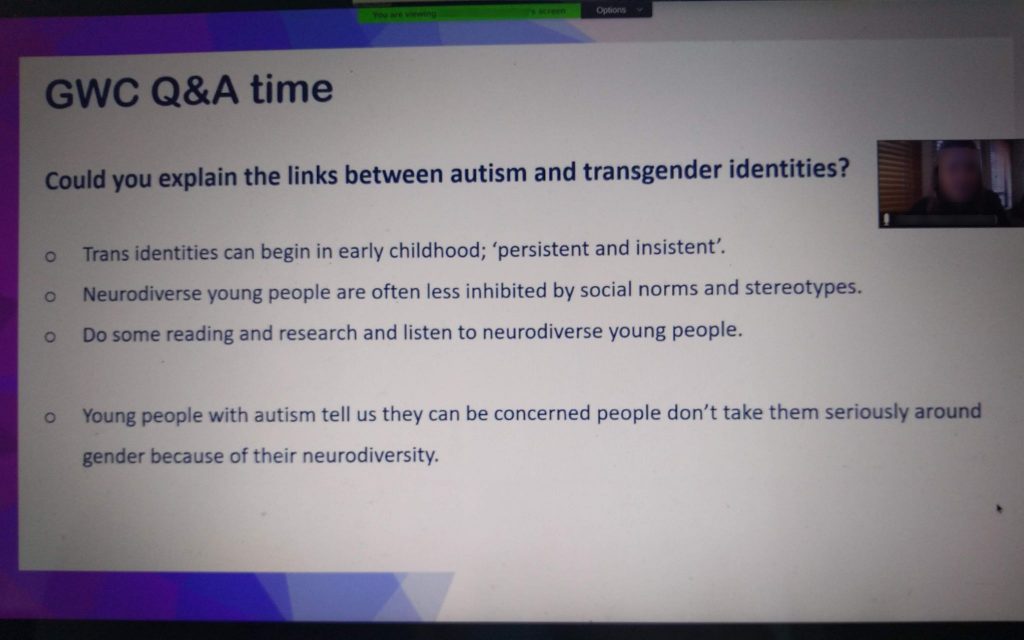
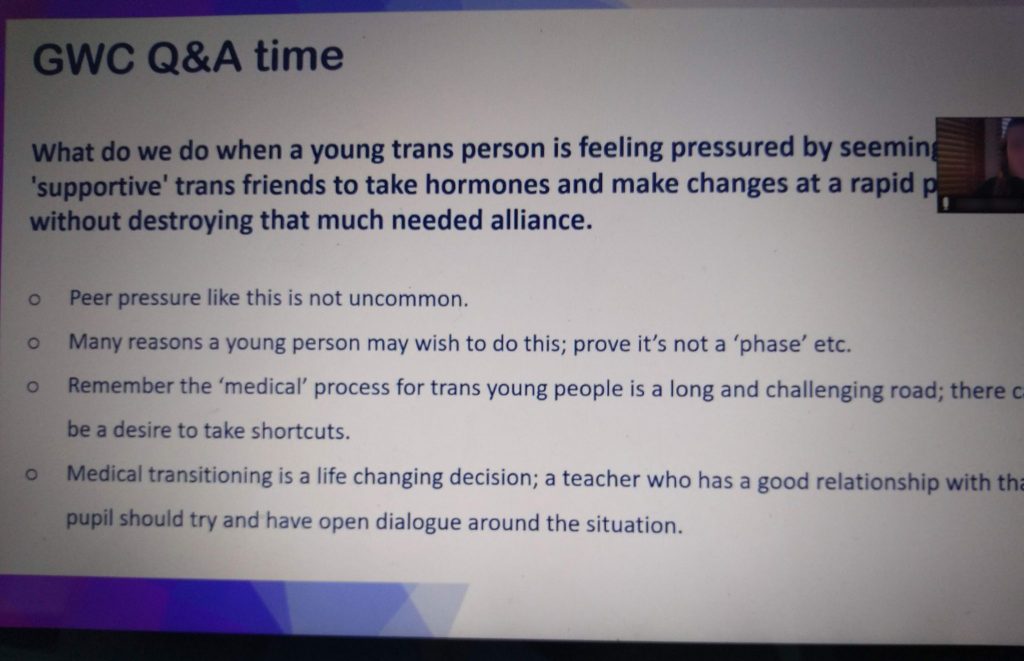
And I can see some people having to like run out already. People saying thank you. Thanks. Thank you. Yeah, beautiful. So I can kind of really quickly wrap this up, [Teacher name], if that’s helpful. I’ll just, I’ll just jump through these slides. And I won’t go into detail. But just so that you can save them. There was some questions around neurodiverse young people, so I can send through some information on that. And then there was some questions around the pressure to take hormones. And that peer pressure, which is really not uncommon. So I can kind of, I’ll send through these slides as well with the information.
If anyone in this room is dealing with that as well, if you want to have a chat to me specifically about that situation, I’m happy to because obviously, taking hormones outside of a gender identity clinic or outside of a GP eye is really harmful, can be rather really harmful. And then relationships and sexual health in the classroom as well. So some people were talking about how can we make sure it’s more inclusive. So, you know, if you think a resource isn’t as trans inclusive as it could be, you know, you have that option to take that next step to take it to that next level as well. And I’ll send through these resources and signposting.

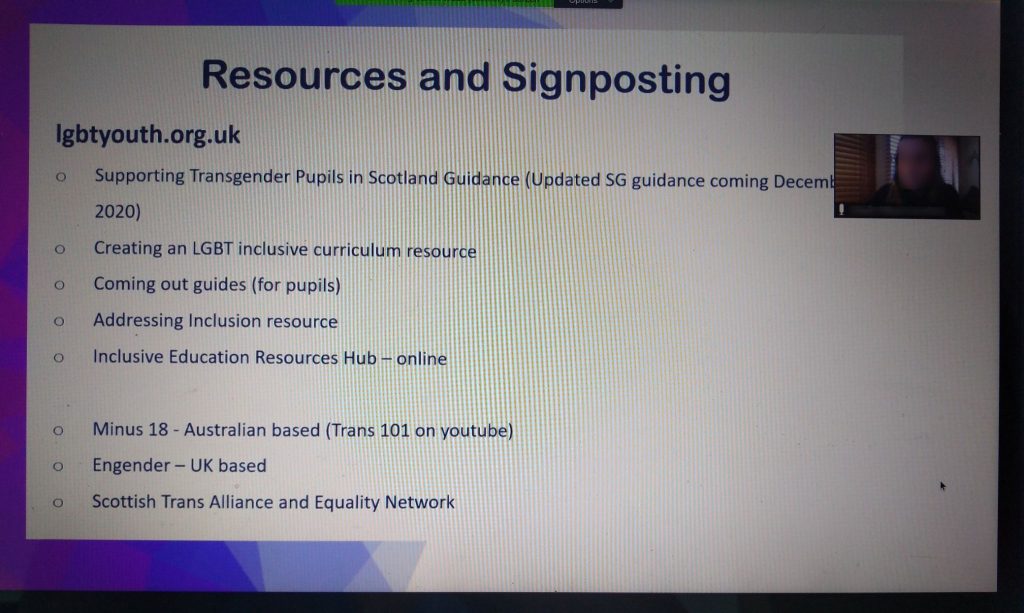

And if anyone is starting from like the base, from the foundation, and not really knowing a lot about trans identities, I really recommend watching Trans 101 by Minus 18. On YouTube, it’s like a seven minute video. And it’s really, really helpful. I often use it in training when I have time. And I’ll, again, we’ll send these through, and then obviously signposting young people if they need that support, we run our youth groups, which used to be face to face and now online. So if young people are looking for support specifically, they’re welcome to get in touch. And I’m just seeing if I, I don’t think I have missed any questions. Yeah, if I can come to you then [Teacher name].
Speaker 6
Okay. Em, yeah, thank you so much for that [Host’s name], that was really helpful. I think, particularly the information about the social transition, I’ve never really heard that term before. So that’s quite, that was really useful. And yeah, I’d be really keen to hear more about that affirmative approach, so if that was something, maybe in the future we could possibly like, arrange, and but what, if you could send out the slides, I can pass that around to everyone. For anyone who’s still here I just popped [Host’s name] email in the chat function so I’m sure she would love it if you had any questions, just to get in contact, and that’s just in there. So yeah, just thank you very much for doing that for us today. And we know it’s not easy.
Speaker 1 – Education Capacity Building Officer, LGBT Youth Scotland
Yeah. No, no worries. Thanks, thanks everybody.
References
[1] This refers to a meeting at the Scottish Parliament where David Bell, Consultant Psychiatrist, spoke. A copy of his speech “First Do No Harm” is here.
David was the former staff governor for Tavistock and Portman NHS Foundation Trust, and is facing disciplinary action after whistle-blowing and calling for all experimental hormone treatment for children to be suspended. There is a Crowd Justice fund for his legal advice.
